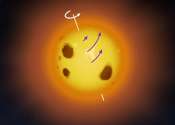Gaia spots possible moons around hundreds of asteroids
ESA's star-surveying Gaia mission has again proven to be a formidable asteroid explorer, spotting potential moons around more than 350 asteroids not known to have a companion.
Astronomy and Astrophysics is a peer-reviewed scientific journal covering theoretical, observational and instrumental astronomy and astrophysics. It was published by Springer-Verlag from 1969–2000, while EDP Sciences published the companion A Supplement Series. In 2000, the two journals merged, with the combined journal known simply as Astronomy and Astrophysics and published by EDP Sciences. The journal copyright is owned by the European Southern Observatory. Astronomy and Astrophysics was formed in 1969 by the merging of several national journals of individual European countries. These journals, with their ISSN and date of first publication are as follows: The publishing of Astronomy and Astrophysics was further extended in 1992 by the incorporation of Bulletin of the Astronomical Institutes of Czechoslovakia, established in 1947. The original sponsoring countries were the four countries whose journals merged to form Astronomy and Astrophysics (France, Germany, the Netherlands and Sweden), together with Belgium, Denmark, Finland, and Norway. The European Southern Observatory also participated as a "member country". Norway later withdrew, but Austria, Greece, Italy, Spain, and

ESA's star-surveying Gaia mission has again proven to be a formidable asteroid explorer, spotting potential moons around more than 350 asteroids not known to have a companion.
Astronomy
Aug 8, 2024
0
171

A surprising discovery about the evolution of our galaxy using data from the Gaia mission found a large number of ancient stars on orbits similar to that of our sun. They formed the Milky Way's thin disk less than 1 billion ...
Astronomy
Jul 31, 2024
4
202

Our solar system is our immediate cosmic neighborhood. We know it well: the sun at the center; then the rocky planets Mercury, Venus, Earth, and Mars; and then the asteroid belt; followed by the gas giants Jupiter and Saturn; ...
Planetary Sciences
Jul 31, 2024
0
45

The sun rotates the fastest at the equator, whereas the rotation rate slows down at higher latitudes and is the slowest at the polar regions. But a nearby sun-like star—V889 Herculis, some 115 light years away in the constellation ...
Astronomy
Jul 31, 2024
0
159

Towards the center of our Milky Way galaxy, in the constellation Sagittarius, astronomers have discovered 10 monstrous neutron stars. These particular stars, called pulsars, reside together in globular cluster Terzan 5, a ...
Astronomy
Jul 16, 2024
11
249

An international research group led by the Italian National Institute for Astrophysics (INAF) and comprising 34 research institutes and universities worldwide utilized the Near-Infrared Spectrograph (NIRSpec) on board the ...
Astronomy
Jul 5, 2024
0
447

An international team led by UNIGE, UNIBE and PlanetS has shown the existence of two distinct populations of sub-Neptunes, resolving a debate in the scientific community.
Astronomy
Jun 27, 2024
0
81

Supermassive black holes pose unanswered questions for astronomers around the world, not the least of which is "How do they grow so big?" Now, an international team of astronomers, including researchers from Chalmers University ...
Astronomy
Jun 20, 2024
0
87

Photographing faint objects close to bright stars is incredibly difficult. Yet, by combining data from ESA's Gaia space telescope with ESO's GRAVITY instrument on the ground, scientists managed just that. They took the first ...
Astronomy
Jun 20, 2024
0
325

In late 2019, the previously unremarkable galaxy SDSS1335+0728 suddenly started shining brighter than ever before. To understand why, astronomers have used data from several space and ground-based observatories, including ...
Astronomy
Jun 18, 2024
0
154